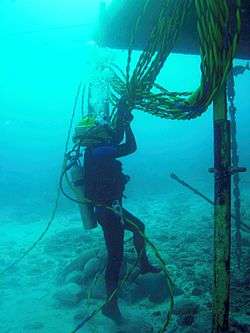Aquanaut
An aquanaut is any person who remains underwater, breathing at the ambient pressure for long enough for the concentration of the inert components of the breathing gas dissolved in the body tissues to reach equilibrium, in a state known as saturation. Usually this is done in an underwater habitat on the seafloor for a period equal to or greater than 24 continuous hours without returning to the surface. The term is often restricted to scientists and academics, though there were a group of military aquanauts during the SEALAB program. Commercial divers in similar circumstances are referred to as saturation divers. An aquanaut is distinct from a submariner, in that a submariner is confined to a moving underwater vehicle such as a submarine that holds the water pressure out. Aquanaut derives from the Latin word aqua ("water") plus the Greek nautes ("sailor"), by analogy to the similar construction "astronaut".

The first human aquanaut was Robert Sténuit, who spent 24 hours on board a tiny one-man cylinder at 200 feet (61 m) in September 1962 off Villefranche-sur-Mer on the French Riviera.[1][2][3] Military aquanauts include Robert Sheats, author Robin Cook, and astronauts Scott Carpenter and Alan Shepard. Civilian aquanaut Berry L. Cannon died of carbon dioxide poisoning during the U.S. Navy's SEALAB III project.[4][5][6] Scientific aquanauts include Sylvia Earle, Jonathan Helfgott, Joseph B. MacInnis,[7] Dick Rutkowski, Phil Nuytten, and about 700 others, including the crew members (many of them astronauts) of NASA's NEEMO missions at the Aquarius underwater laboratory.
Russian military program
A unit of the Russian navy has developed an aquanaut program that has deployed divers more than 300 meters deep. An ocean vessel has been developed and is based in Vladivostok that is specialized for submarine and other deep sea rescue and that is equipped with a diving complex and a 120-seat deep sea diving craft.[8]
Accidental aquanaut
A Nigerian ship's cook, Harrison Odjegba Okene, survived for 60 hours in a sunken tugboat, Jascon-4, that capsized on 26 May 2013 in heavy seas while it was stabilising an oil tanker at a Chevron platform in the Gulf of Guinea[9] in the Atlantic Ocean, about 32 km (20 mi) off the Nigerian coast.
The boat came to a rest upside down on the sea bottom, at a depth of 30 m (98 ft). Eleven crew members died, but in total darkness, Okene felt his way into the engineer's office 1.2 m (3 ft 11 in) in height that contained air sufficient to keep him alive. There, he fabricated a platform from a mattress and other materials which kept the upper part of his body above water that helped reduce heat loss.[10][11][12][13]
Three days after the accident, Okene was discovered by South African divers employed to investigate the scene and recover the bodies. The rescuing divers fitted Okene with a diving helmet so he could breathe while being transferred into a closed diving bell and returned to the surface for decompression from saturation. Okene lost consciousness during the transfer.[9]
See also
- Jonah, Biblical figure said to have lived in a whale for three days
- Continental Shelf Station Two – Undersea research habitat in the Red Sea
- Jacques Cousteau – French inventor of open circuit scuba, pioneer diver, author, film-maker and marine researcher
- World Without Sun – 1964 film by Jacques Cousteau
Notes
- Sténuit, Robert (1966). The Deepest Days. Trans. Morris Kemp. New York: Coward-McCann.
- Ecott, Tim (2001). Neutral Buoyancy: Adventures in a Liquid World. New York: Atlantic Monthly Press. pp. 249–250. ISBN 0-87113-794-1. LCCN 2001018840.
- Norton, Trevor (2006). Underwater to Get Out of the Rain: a love affair with the sea. Da Capo Press. p. 191. ISBN 0-306-81487-0.
- Ecott, pp. 264-266.
- staff (1969-02-28). "Oceanography: Death in the Depths". Time. Retrieved 2013-04-14.
- Davis, Michael (1979). "Immersion hypothermia in scuba diving". South Pacific Underwater Medicine Society Journal (reprint from New Zealand Journal of Sports Medicine). 9 (2). Retrieved 2013-04-14.
- "Dr. Joe MacInnis". www.drjoemacinnis.com. Retrieved December 29, 2011.
- Asia Times 11 March 2018, "Russian Military Set for A Record-Breaking Deep Dive, Russia’s Specially Trained ‘Aquanauts’ Are Getting Ready for A Very Unusual, Taxing and Highly Dangerous Operation in The Depths of the Ocean," http://www.atimes.com/article/russian-military-set-for-a-record-breaking-deep-dive/
- Top Ten Weather Disasters. The Weather Channel. August 27, 2016.
- Sifferlin, Alexandra. "Man Survives 60 Hours Under Water In Sunken Ship". Time. Time Inc. Retrieved 23 June 2016.
- "Nigerian survives two days at sea, in underwater air pocket". BBC News - Africa. British Broadcasting Corporation. 13 June 2013. Retrieved 23 June 2016.
- Moran, Terry (December 3, 2013). "Cook Survives 3 Days in Air Pocket of Sunken Ship Off Nigerian Coast". ABC News. Retrieved 23 June 2016.
- Lallanilla, Marc (December 4, 2013). "Undersea Miracle: How Man in Sunken Ship Survived 3 Days". LiveScience.com. Retrieved 23 June 2016.
References
- Flemming, N. C.; Max, M. D. (eds.). Code of Practice for Scientific Diving: Principles for the Safe Practice of Scientific Diving in Different Environments. UNESCO Technical Papers in Marine Science 53.
- Hellwarth, Ben (2012). Sealab: America's Forgotten Quest to Live and Work on the Ocean Floor. New York: Simon & Schuster. ISBN 978-0-7432-4745-0. LCCN 2011015725.
- Joiner, James T., ed. (2001). NOAA Diving Manual: Diving for Science and Technology, Fourth Edition. U.S. Department of Commerce, National Technical Information Service. ISBN 0-941332-70-5.
- Miller, James W.; Koblick, Ian G. (1995). Living and Working In the Sea. Best Publishing Company. ISBN 1-886699-01-1.
- Swanson, Jennifer (2018). Astronaut, Aquanaut: How Space Science and Sea Science Interact. Washington, D.C.: National Geographic Partners. ISBN 978-1-4263-2867-1. LCCN 2017020436.